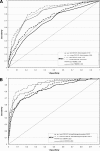Predicting diabetes: clinical, biological, and genetic approaches: data from the Epidemiological Study on the Insulin Resistance Syndrome (DESIR)
- PMID: 18689695
- PMCID: PMC2551654
- DOI: 10.2337/dc08-0368
Predicting diabetes: clinical, biological, and genetic approaches: data from the Epidemiological Study on the Insulin Resistance Syndrome (DESIR)
Abstract
Objective: To provide a simple clinical diabetes risk score and to identify characteristics that predict later diabetes using variables available in the clinic setting as well as biological variables and polymorphisms.
Research design and methods: Incident diabetes was studied in 1,863 men and 1,954 women, 30-65 years of age at baseline, with diabetes defined by treatment or by fasting plasma glucose >or=7.0 mmol/l at 3-yearly examinations over 9 years. Sex-specific logistic regression equations were used to select variables for prediction.
Results: A total of 140 men and 63 women developed diabetes. The predictive clinical variables were waist circumference and hypertension in both sexes, smoking in men, and diabetes in the family in women. Discrimination, as measured by the area under the receiver operating curves (AROCs), were 0.713 for men and 0.827 for women, a little higher than for the Finish Diabetes Risk (FINDRISC) score, with fewer variables in the score. Combining clinical and biological variables, the predictive equation included fasting glucose, waist circumference, smoking, and gamma-glutamyltransferase for men and fasting glucose, BMI, triglycerides, and diabetes in family for women. The number of TCF7L2 and IL6 deleterious alleles was predictive in both sexes, but after including the above clinical and biological variables, this variable was only predictive in women (P < 0.03) and the AROC statistics increased only marginally.
Conclusions: The best clinical predictor of diabetes is adiposity, and baseline glucose is the best biological predictor. Clinical and biological predictors differed marginally between men and women. The genetic polymorphisms added little to the prediction of diabetes.
Figures
References
-
- Waugh N, Scotland G, McNamee P, Gillett M, Brennan A, Goyder E, Williams R, John A: Screening for type 2 diabetes: literature review and economic modelling. Health Technol Assess 11:1–125, 2007 - PubMed
-
- Lindström J, Tuomilehto J: The diabetes risk score: a practical tool to predict type 2 diabetes risk. Diabetes Care 26:725–731, 2003 - PubMed
-
- Saaristo T, Peltonen M, Lindström J, Saarikoski L, Sundvall J, Eriksson JG, Tuomilehto J: Cross-sectional evaluation of the Finnish Diabetes Risk Score: a tool to identify undetected type 2 diabetes, abnormal glucose tolerance and metabolic syndrome. Diab Vasc Dis Res 2:67–72, 2005 - PubMed
-
- Schmidt MI, Duncan BB, Bang H, Pankow JS, Ballantyne CM, Golden SH, Folsom AR, Chambless LE; The Atherosclerosis Risk in Communities Investigators: Identifying individuals at high risk for diabetes: the Atherosclerosis Risk in Communities study. Diabetes Care 28:2013–2018, 2005 - PubMed
Publication types
MeSH terms
Grants and funding
LinkOut - more resources
Full Text Sources
Other Literature Sources
Medical


